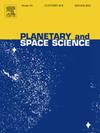彗星尘埃彗星的复合相函数
IF 1.7
4区 物理与天体物理
Q3 ASTRONOMY & ASTROPHYSICS
引用次数: 0
摘要
彗星代表了我们现在可以研究的保存最完好的星子,尘埃是它们的主要组成部分之一。一旦在彗发中发射,彗星尘埃颗粒代表入射太阳光线的各向异性散射体,它们的性质可以通过遥感研究来研究。其中,相函数曲线的测量在若干科学领域具有重要意义。它可以通过理论和实验室研究来反转,以获得关于发射尘埃的亲密性质的提示。当在大时间间隔内获得的数据相互关联时,还需要调整相角效应的彗星尘埃产生率。最后,它对空间仪器规划很有用,因为它为遥感传感器在近距离接近时观测跨越大范围相位角的彗发提供了最佳曝光时间的输入。这将在未来ESA彗星拦截器任务的框架内特别有价值,该任务将飞越一颗首次进入我们内太阳系的动态新彗星,携带仪器将在短时间内以不同的观测几何形状和相位角对彗发进行成像。为了提供一个有用的工具来解决上述科学问题,我们利用现有的文献数据建立了一个新的彗星尘埃彗发的复合相位函数。这是将heney - greenstein函数拟合到11颗彗星的原始数据中,然后以连续的方式将它们连接起来,因为所有的数据值都来自一颗平均彗星。然后,我们用复合heney - greenstein曲线拟合我们的结果,并将其与之前的模型进行比较,这些模型不包括最近的文献数据,这些数据构成了彗星在小相角和大相角的精细后续。主要的区别在于对前向散射浪涌的描述,我们的模型描述的强度比以前的模型大一个数量级。这一发现非常重要,因为它表明,模型的选择可能会在解释或仪器规划前向散射数据时产生严重后果。本文章由计算机程序翻译,如有差异,请以英文原文为准。

A composite phase function for cometary dust comae
Comets represent the most preserved planetesimals we can nowadays study and dust is one of their major components. Once emitted in the coma, cometary dust particles represent anisotropic scatterers of the incident solar light and their nature can be investigated with remote sensing studies. Among them, the measurement of the phase function curve has a key importance in several scientific aspects. It can be inverted with theoretical and laboratory studies to derive hints on the intimate nature of the emitted dust. It is also needed in adjusting cometary dust production rates for phase angle effects when data obtained throughout large time intervals are correlated. Finally, it is useful for space instruments planning since it provides inputs for optimal exposure times for remote sensing sensors which observe the coma spanning a large range of phase angles during close approaches. This will be particularly valuable in the framework of the future ESA Comet Interceptor mission which is going to fly-by a Dynamically New Comet entering our Inner Solar System for the very first time, carrying instruments which will image the coma with different observing geometries and phase angles in a short amount of time. In order to provide an useful tool to address the aforementioned scientific topics, we used available literature data to build a new composite phase function for cometary dust comae. This was obtained fitting Henyey–Greenstein functions to the original data of 11 comets and then connecting them in a continuous way as all data values were coming from a single average comet. We then fitted our result with a compound Henyey–Greenstein curve and compared it with previous models which were not including recent literature data constituting fine follow-ups of comets at small and large phase angles. The main difference is found in the description of the forward scattering surge, where our model depicts intensity one order of magnitude larger than previous ones. This finding is extremely important since it shows that the choice of the model may have severe consequences when interpreting, or instrumentally planning, forward scattering data.
求助全文
通过发布文献求助,成功后即可免费获取论文全文。
去求助
来源期刊

Planetary and Space Science
地学天文-天文与天体物理
CiteScore
5.40
自引率
4.20%
发文量
126
审稿时长
15 weeks
期刊介绍:
Planetary and Space Science publishes original articles as well as short communications (letters). Ground-based and space-borne instrumentation and laboratory simulation of solar system processes are included. The following fields of planetary and solar system research are covered:
• Celestial mechanics, including dynamical evolution of the solar system, gravitational captures and resonances, relativistic effects, tracking and dynamics
• Cosmochemistry and origin, including all aspects of the formation and initial physical and chemical evolution of the solar system
• Terrestrial planets and satellites, including the physics of the interiors, geology and morphology of the surfaces, tectonics, mineralogy and dating
• Outer planets and satellites, including formation and evolution, remote sensing at all wavelengths and in situ measurements
• Planetary atmospheres, including formation and evolution, circulation and meteorology, boundary layers, remote sensing and laboratory simulation
• Planetary magnetospheres and ionospheres, including origin of magnetic fields, magnetospheric plasma and radiation belts, and their interaction with the sun, the solar wind and satellites
• Small bodies, dust and rings, including asteroids, comets and zodiacal light and their interaction with the solar radiation and the solar wind
• Exobiology, including origin of life, detection of planetary ecosystems and pre-biological phenomena in the solar system and laboratory simulations
• Extrasolar systems, including the detection and/or the detectability of exoplanets and planetary systems, their formation and evolution, the physical and chemical properties of the exoplanets
• History of planetary and space research
 求助内容:
求助内容: 应助结果提醒方式:
应助结果提醒方式:


